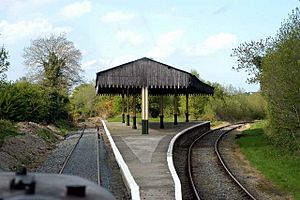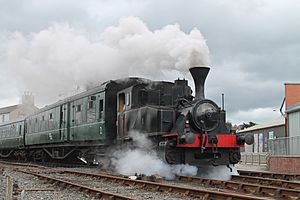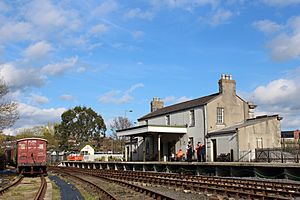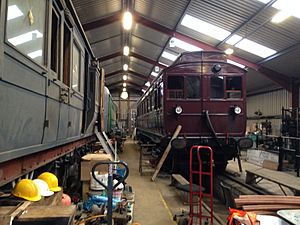Downpatrick and County Down Railway facts for kids
Quick facts for kids Downpatrick and County Down Railway |
|
|---|---|
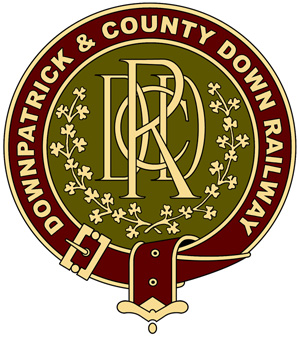
The DCDR logo, based on a monogram design used by the BCDR
|
|
| Locale | Northern Ireland |
| Commercial operations | |
| Name | Belfast and County Down Railway |
| Built by | Belfast and County Down Railway |
| Original gauge | 1,600 mm (5 ft 3 in) |
| Preserved operations | |
| Operated by | The Downpatrick and County Down Railway Society Limited |
| Stations | 4 |
| Length | Approximately 3 miles (4.8 km) |
| Preserved gauge | 1,600 mm (5 ft 3 in) |
| Commercial history | |
| Opened | 1859 |
| Closed | 1950 |
| Preservation history | |
| Jan 1985 | Work started on building preserved railway |
| Dec 1987 | First public trains ran |
| Apr 1995 | South Line extended to Magnus' Grave |
| Sep 2005 | North Line extended to Inch Abbey |
| Sep 2014 | Carriage Gallery officially opened |
| Mar 2020 | Railway closes during COVID-19 pandemic |
| Jul 2022 | Railway reopens to public |
| Oct 2023 | Railway Temporarily Closes due to severe flooding and resulting damage |
| Oct 2024 | Railway reopens following flood damage |
| Website | |
| downrail.co.uk | |
The Downpatrick and County Down Railway (DCDR) is a special old railway in County Down, Northern Ireland. It uses a unique track width of 5 feet, 3 inches (1,600 mm). This railway is run by amazing volunteers. They operate passenger trains using old steam and diesel engines, plus vintage carriages.
The DCDR has about three miles (4.8 km) of track. It connects the town of Downpatrick to historical places. These include Inch Abbey to the north and King Magnus’ Grave to the south. The railway also has a museum. Here, you can see old railway items and trains from the 1860s to the 1980s. These come from both Northern Ireland and the Republic of Ireland.
A group of local train fans started the DCDR in the early 1980s. Building the railway began in 1985. Most of its tracks are on parts of the old Belfast and County Down Railway (BCDR) line. This line used to run between Belfast, Downpatrick, and Newcastle. The DCDR first opened to the public in December 1987. It has grown a lot since then. The line to Inch Abbey was finished in 2005, making it its current length.
The DCDR is the only railway in Ireland with this special track width. This width has been standard in Ireland since the 1840s. The Downpatrick station is near Down Cathedral and the Saint Patrick Centre. This makes the railway a popular spot for tourists. It has hundreds of members who love trains! The DCDR has three steam engines and eight diesel engines. It also has the largest collection of Victorian railway carriages in Ireland. Volunteers have worked hard to fix up many of these old carriages. Some have even won awards for their restoration.
Contents
History of the Railway
The First Railway in Downpatrick
The very first railway in Downpatrick opened in March 1859. This was when the Belfast and County Down Railway line from Belfast Queen's Quay was finished. Downpatrick had a large station building on Market Street. It also had a two-track train shed, a goods store, and an engine shed. There was even a turntable to turn engines around.
Sir John Macneill, the BCDR's chief engineer, managed the building of this line. It included a bridge over the River Quoile estuary. This area was often flooded, especially in winter. The original bridge was replaced with a steel bridge in 1929.
Expanding the Line
The railway first ended in Downpatrick. But in 1869, a new company built an extension. This line went from Downpatrick to the seaside town of Newcastle. The BCDR operated this new Newcastle line and bought it in 1881.
This extension caused a problem. Trains going between Belfast and Newcastle had to stop in Downpatrick. The engine had to uncouple and move to the other end of the train. This took a lot of time and made the station very busy.
In 1892, a solution appeared. The Downpatrick, Killough and Ardglass Railway opened, along with Downpatrick Loop Platform. This new Ardglass line was also built and run by the BCDR. It branched off the main line about a kilometre south of Downpatrick station. A loop line was built to connect the Newcastle and Belfast lines directly. The Loop Platform was at this South Junction.
This meant trains from Belfast going to Newcastle could bypass the main Downpatrick station. They would stop at the Loop Platform instead. Passengers for Downpatrick or Ardglass could then switch to a local train. This created a unique triangular-shaped layout. Today, most of the DCDR's tracks follow this original triangle.
Railway Closure
A train crash in 1945 caused the BCDR to lose a lot of money. Because of this, the company became part of the Ulster Transport Authority (UTA) in 1948. Northern Ireland's government decided to close many railway lines. They wanted to save money and improve road services.
The entire Belfast – Newcastle line south of Comber closed on January 15, 1950. This included Downpatrick. The tracks and most railway buildings were removed by 1953. The station was then used by the UTA's bus division, which later became Ulsterbus. Most of the land where the tracks used to be was sold. The land around Downpatrick was bought by Lord Dunleath.
The 1929 Quoile Bridge was taken apart for scrap. But the Loop Platform and some smaller bridges were left. The station building was knocked down in the 1970s. Part of the old station yard became a storage area.
The Heritage Railway Begins
Local architect Gerry Cochrane M.B.E. had an idea. He wanted to rebuild part of the old railway as a heritage steam railway. By 1982, he had support from the local council. Lord Dunleath gave the new railway society land to build the line and station. This land was near the old Downpatrick station.
Work on rebuilding the railway began in 1985. Public trains started running again on December 4, 1987. This made it the first Irish gauge heritage railway in Ireland to carry passengers on its own tracks. Almost 6 km (4 miles) of track have been relaid. There are plans to extend the line south to Ballydugan.
The railway was first called the Downpatrick & Ardglass Railway. But plans to extend to Ardglass were dropped. In 1996, it became the Downpatrick Railway Museum. Then, in 2005, it was renamed the Downpatrick & County Down Railway. This happened after the Inch Abbey extension opened.
The railway closed to the public from March 2020 to July 2022 due to the COVID-19 pandemic. Volunteers kept working during this time. Normal service started again on July 16, 2022.
In November 2023, the railway closed again. Heavy rain from Storm Ciarán flooded the entire site for almost a week. The railway was closed for nearly a year. Volunteers worked hard to fix the damage to trains and tracks. It finally reopened on October 26, 2024.
How the Railway Works
The DCDR has about three miles (4.8 km) of track open. They run steam engines, like O&K No. 1 or 3. They also use diesel engines from the 1950s and 60s. These engines pull preserved rolling stock.
Passenger trains usually use certain carriages. These include coach 3223 (built 1954), coach 728 (built 1951), and coach 1944 (built 1954). Older, very special carriages are now mostly kept inside for display. They are used only on a few special days. This helps protect them because they are so historically important.
The railway also wants to have an old-fashioned mechanical signalling system. This will use preserved signal cabins and semaphores. They also plan a "Double Track Project." This will let trains run at the same time on the North and South lines.
Special Train Events
Every year, the DCDR runs several special trains:
- Saint Patrick's Day Specials: These trains run on Saint Patrick's Day to Inch Abbey.
- Easter Specials: These run for a few days around Easter to Inch Abbey.
- May Day Specials: These run on May Day to Inch Abbey.
- Summer Specials: These run every weekend in summer to Inch Abbey. Some days have special events, including an annual diesel day.
- EHOD Days: These happen with the last Summer Specials weekend. Visitors can get free rides in a diesel engine cab and go on behind-the-scenes tours.
- Halloween Specials: These run on the weekend before Halloween and on Halloween night. They go to Magnus' Grave.
- Santa Specials: These run on the weekend before Christmas and go to the Loop Platform.
- Mince Pie Specials: These run on the last weekend of the year. They go to Magnus' Grave or Inch Abbey and are usually pulled by a diesel engine.
They also have extra trains for holidays, private groups, and even for filming movies!
Things to See and Do
On days when trains are running, visitors can explore many areas:
- The BCDR Museum is upstairs in Downpatrick railway station.
- You can visit the Downpatrick East signal cabin.
- There is a model railway room.
- You can see the workshop viewing area, where carriages are being restored.
- The Carriage Gallery is also open.
A gift shop and a buffet carriage are open on operating days. The buffet carriage is usually at Inch Abbey or Downpatrick Loop Platform railway station.
Stations and Buildings
Railway Stations
- Downpatrick Station is the main station. All passenger trains start here. It has two platforms, but one is not used right now. The original station was on Market Street, but it was knocked down before the DCDR started.
- Downpatrick Loop Platform cannot be reached by road. This helped it avoid being demolished in the 1950s. It's where trains switch between the DCDR's South and Loop lines. It has two platforms.
- King Magnus' Halt is the end of the South Line. It has one platform. It serves the grave of Viking King Magnus Barefoot. This spot was hard to reach before the railway. This halt was not part of the original BCDR stations.
- Inch Abbey Halt is the end of the North Line. It has two platforms and serves the ruins of Inch Abbey. This station was not part of the original BCDR. It is on a slightly different path from the old track.
Buildings and Structures
Many of the railway's buildings are original. They were first built in other parts of Northern Ireland. Then, they were carefully moved brick-by-brick to Downpatrick.
- Downpatrick Station Building was originally the town's Gas Manager's House. It was moved brick-by-brick from across the road.
- Downpatrick Signal Cabin was moved from Kingsbog Junction.
- Downpatrick East Signal Cabin was originally Bundoran Junction's North Cabin. It was moved in 2011 and opened to the public in 2017.
- Downpatrick Locomotive Shed was moved stone-by-stone from Maghera. It was originally a goods shed there.
- Downpatrick Station Canopy was originally attached to the Maghera Shed.
- Downpatrick Water Tower was moved from Antrim station.
- The Arch is over the main gate. It has the railway's name and is based on a design from Cookstown.
- Bridges 163 & 164 are original BCDR bridges. They cross a small stream.
- Downpatrick Loop Platform and Canopy are the only original BCDR buildings left in Downpatrick.
- The Cutting is just past where passenger trains go on the South Line. It takes trains up a hill with walls on both sides.
- The Quoile Bridge is the longest bridge on the DCDR. It carries the North Line over the River Quoile. The concrete center part is original, but the bridge spans are new.
Carriage Gallery Museum
The Carriage Gallery was finished in 2012. It's a museum where you can see trains that are not currently running. It's like a big indoor display area. Here, visitors can get close to the vehicles and learn about Irish railways. Even though it's called the "Carriage Gallery," it also has steam and diesel engines.
The gallery is designed to look like old Victorian train stations. The trains are arranged on three tracks with platforms. This lets visitors go inside some of the vehicles. You can see trains in different conditions, from fully restored to how they were found. This shows how much work goes into fixing them up. The Carriage Gallery was officially opened in 2014.
Train Collection
The DCDR has a large collection of railway vehicles. This includes three steam engines, twelve diesel engines, seven diesel railcar sets, twenty-four carriages, thirty-eight wagons, and four special track maintenance vehicles. In total, there are eighty-four railway vehicles.
Engines
Currently, O&K Nos. 1 and 3 are the steam engines that can run. GSWR No.90, built in 1875, is Ireland's oldest steam engine that can still operate. It arrived in Downpatrick in 2007.
The railway also has several diesel engines. Two E Class diesels, E421 and E432, arrived in 1986. E421 pulled the first passenger trains. Three G Class diesels help with moving trains around. The Irish Traction Group also loans seven larger diesel engines to the railway.
Railcars
The DCDR has several railcars. Railcar B, built in 1947, was given to the railway in 2006. It needs a lot of work to run again. They also have the last 450 Class railcar, 458 Antrim Castle. This one arrived in 2014 and has been turned into a buffet train. Two 80 class railcars arrived in 2018.
Carriages
The DCDR uses different groups of carriages for different purposes:
- Old Buffet: These are 1950s carriages used as a buffet train and Santa's Grotto in autumn and winter.
- New Buffet: This uses a 450 Class railcar and DBSO as the buffet train in spring and summer.
- Everyday Running Set: These are 1950s carriages used on most running days.
- Vintage Running Set: These are very old carriages, usually on display. They are used for special events.
The everyday running set usually has CIÉ 1944 and UTA 728. A generator van, CIÉ 3223, is added in autumn and winter for heat and light. On special days, the Vintage Set is used. This includes BCDR Nos. 72 and 148, and GSWR 836.
The DCDR has a wide variety of carriages. They have vehicles from almost every time period and railway company in Ireland. This includes the BCDR, GNR, and Ulster Railway. Ulster Railway No. 33 is the only surviving vehicle from that company. It is Ulster's oldest carriage. Other special carriages include BCDR Railmotor No. 72 and Royal Saloon No. 153.
Wagons
The DCDR also has many wagons, goods vans, and underframes. Ex-NCC brake van No. 33 was the first vehicle to carry passengers on the railway. The collection also includes the most powerful steam crane in Ireland, NCC No. 3084. Most wagons are stored, but a few are used for track work. The DCDR hopes to build a special goods shed for its wagons in the future. In August 2022, a full ballast train with three hoppers and a plough van arrived.
The railway's track maintenance team uses a small fleet of special vehicles. These were all acquired from NIR.
Awards and Recognition
The Downpatrick and County Down Railway has won many awards for its work:
- National Railway Heritage Awards; Ian Allan Railway Heritage Award (First Class): In 1992, for the Downpatrick Station Building.
- Northern Ireland Tourist Board and British Airways Tourism Awards (Highly commended): In December 1999, for 'Best Project'.
- Heritage Railway Association; Carriage and Wagon Award (Highly commended): In 1999, for GSWR carriage No. 836.
- Down District Council; Tourism Heroes Award: In May 2008.
- Co-operation Ireland; Pride Of Place Award: In November 2012.
- Heritage Railway Association; Small Groups Award: In 2014, for involving young people and its museum development.
- Heritage Railway Association; Carriage and Wagon Award: In 2019, for restoring BCDR railmotor No. 72.
- Ulster Architectural Heritage Society; Heritage Angel Awards (Highly commended): In October 2019, for restoring Bundoran Junction North signal cabin.
- National Railway Heritage Awards; Abellio Signalling Award (Highly commended): In December 2019, also for restoring Bundoran Junction North signal cabin.
- Heritage Railway Association; Lord Faulkner Young Volunteer Award: Received in February 2024, and was a runner-up in March 2022.
- Social Enterprise Northern Ireland Awards; Social Enterprise of the Year (Under £500k): Received in November 2024.
- Social Enterprise Northern Ireland Awards; Emerging Leader of the Year: Received in November 2024.
- Social Enterprise Northern Ireland Awards; Leader of the Year (runner-up): Received in November 2024.
- Heritage Railway Association; Team of the Year: Received in February 2025.
- Heritage Railway Association; Achievement of the Year: Received in February 2025.
On TV and in Movies
The DCDR has been featured in many TV shows and films:
- Children in Need Quiet Man Spoof (BBC One NI, 2001)
- Puckoon (2002)
- Flight to Freedom (BBC One NI, 2005)
- Rain (2005)
- A Potted History of Armagh (BBC One NI, 2006)
- Raising Steam (BBC One NI, 2008)
- Our Wee World (BBC One NI/Barking Films, 2010)
- Christopher and His Kind (BBC2/Mammoth Screen, 2011)
- Wodehouse in Exile (BBC 4, 2013)
- Walk the Line (Barra Best, BBC NI, 2014)
- The Lost City of Z (2015)
- A Patch of Fog (2015)
- The Woman in White (BBC, 2017)
- The Last Letter (BBC NI, 2018)
- Mrs Wilson (BBC, 2018)
- Agatha and the Truth of Murder (Channel 5, 2018)
- Extreme Railways (Channel 5, 2019)
- Derry Girls (Channel 4, 2022)
See also
- List of heritage railways in Northern Ireland
- History of rail transport in Ireland
- Sir John Macneil


